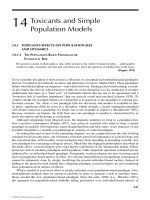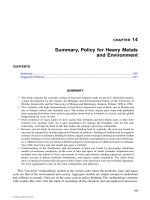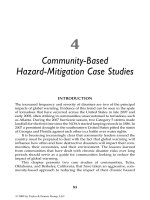Corporate Environmental Management - Chapter 14 pot
Bạn đang xem bản rút gọn của tài liệu. Xem và tải ngay bản đầy đủ của tài liệu tại đây (400.77 KB, 10 trang )
125
Chapter 14
Emergency
Response Analysis
Emergency response analysis
is a decision-making tool to identify poten-
tial emergencies facing a community with respect to accidental explo-
sions or releases of compounds from company facilities. By identifying
and evaluating all potential emergencies—including the highly unlikely
worst-case scenarios—decision makers are able to prepare for emergen-
cies and significantly reduce the risks. A population risk-based approach
should be developed to assess a variety of land use, exposed population,
and exposure pathways, as applicable to a given site. In the emergency
response analysis context, safety is the reciprocal of risk, or the probabil-
ity that substances will not produce harm under the same conditions.
Thus, when ultimately determining the risk or safety of the present
approach the critical factor will not necessarily be the intrinsic hazard
potential of the substances per se but the safety precautions that have
been taken to decrease the potential harm from that substance.
It is assumed that the greatest acute hazard potential to the nearest
community will be via air-borne transmission in the form of a vapor, gas, or
dust cloud, or via an explosion of a volatile container. Using these assump-
tions, worst case scenarios for representative compounds should be
conducted to indicate the size of the hazard zones that would have to be
considered in emergency planning for the present approach.
The ARCHIE Model series was developed by the EPA, the Department of
Transportation (DOT), and the Federal Emergency Management Adminis-
tration (FEMA) for use in hazard analysis. EPA’s Automated Resource for
Chemical Hazard Incident Evaluation (ARCHIE) model is the recommended
model in several states as part of the emergency response analysis require-
ment in permit requests. It should be stressed that the assumptions are
considered to be worst case, i.e., the situation is assumed to be the worst
that can occur based on the information. As such, severe combinations of
factors (i.e., temperature, wind, and others) have been fed into the model
than would normally be encountered at a given site that results in exaggera-
tion of the size of hazard zones. Some examples of model components are
briefly discussed below.
55461_C014.fm Page 125 Tuesday, June 5, 2007 10:59 AM
© 2008 by Taylor & Francis Group, LLC
126
CORPORATE ENVIRONMENTAL MANAGEMENT
The condensed-Phase Explosion Model assesses the physically
destructive impact of a potential explosion. The purpose of the Vapor
Dispersion Model is to provide an estimate of the dimensions of the initial
downwind zone that may require protective action in the event of a
hazardous material discharge due to the accidental discharge, emission,
or release of a toxic gas or vapor to the atmosphere. The worst case for
vapor dispersion would be the substance with the highest vapor pressure
and lowest immediately dangerous to life and health (IDLH) dose. This is
because the model assumes that all the contents of the drum will be
released into the atmosphere in one minute, and thus vapor pressure does
not play a significant role.
The Release Pressurized Gas Pipeline Model provides an estimate of
hazard zones if a pipeline with gas under pressure is ruptured during
cleanup activities at a site.
Contingency Plans
OSHA Regulation 29CFR 1910.120 requires written emergency response
plans. Contingency plans and emergency response plans are step-by-step
guides for handling emergencies and include a description and identifica-
tion of the identification and location of hazards, roles and responsibilities,
available equipment, evacuation procedures, and decontamination proce-
dures. It also calls for establishing related issues such as safe distances,
security of a site, PPE, methods of alerting on-site personnel, and notifica-
tions and reporting requirements off-site.
EPA Regulation 40 CFR 355.10 and 372 also requires written emergency
response plans; from the EPA’s standpoint, contingency plans and emer-
gency response plans are step-by-step guides for handling emergencies.
They include a description and identification of response capabilities.
These include:
• Levels of emergencies—standardizes what type of response is
needed and who will be responding
• Notifications—requirements for documentation and record-keeping
of information provided
Planning mitigates the potential for a full emergency to develop. By
conducting risk assessments and analyzing the potential for hazardous
activities to impact employee safety, you can identify the unsafe acts that
lead to accidents and emergencies. Planning for an emergency reduces
the likelihood of it occurring. Pre-incident planning includes knowing the
hazards present, the resources available, and what can reasonably be
accomplished during an incident.
By knowing what hazardous materials are present, the emergency
officer can estimate the likely harm if not controlled, establish response
55461_C014.fm Page 126 Tuesday, June 5, 2007 10:59 AM
© 2008 by Taylor & Francis Group, LLC
127
Emergency Response Analysis
objectives, and weigh offensive or defensive options. Another reason for
pre-planning is to manage the potential outcome of an event. By knowing
the resources available and by understanding what can be accomplished,
the emergency manager has a better chance to manage the outcome of any
situation (magnitude, occurrence, timing, effect, or location).
Up-the-Stack Emergencies
One area that requires particular vigilance is the reporting of accidental
and under-estimated air emission release from industrial facilities. “Up-
the-stack” industrial companies may underestimate emissions for
three reasons:
• Companies are only required to report releases above certain
amounts under both federal and state law. For example, companies
must report the release of carbon monoxide only if more than 5000
pounds is emitted in a 24-hour period. If frequent but smaller
releases occur, they may not be captured because there is no
reporting required.
• Designs typically will call for gases to be routed to a temporary
control feature (e.g., a flare). Company emissions reports usually
assume the control feature is operating at maximum efficiency, i.e.,
destroying a significant percentage of emissions. But there are
times when the secondary capture is incomplete and therefore not
operating at designed efficiency. As a result, the release may be
more than the reported estimates of pollution into the atmosphere.
• Some reports do not state the amount of pollution released at all
but simply note that the reportable quantity has been exceeded.
The unpermitted release of smog-forming volatile organic compounds
(VOC) is of special concern for up-the-stack industrial organizations. In
particular, facilities in communities that are in non-attainment areas that
do not meet health-based standards for ozone must show strong care
with regard to unpermitted releases. High levels of ozone in the atmo-
sphere can result in several known health effects, including irritation of
the respiratory system, reduction of lung capacity, aggravation of
asthma, and inflammation and damage of the lung lining. Scientists also
suspect that ozone may aggravate chronic lung diseases, such as
emphysema and bronchitis.
In addition to elevating the risk of cancer, lung disease, and other ail-
ments associated with long-term exposure to the pollutants released from
up-the-stack industrial facilities, the release of high volumes of pollution in
a short period of time can trigger acute health effects. This may include
asthma, nausea, depression of the nervous system, heightened cardiac
sensitivity, and heart attack. As an example, acute exposure to high con-
centrations of benzene (2000 ppm) can depress the nervous system and
55461_C014.fm Page 127 Tuesday, June 5, 2007 10:59 AM
© 2008 by Taylor & Francis Group, LLC
128
CORPORATE ENVIRONMENTAL MANAGEMENT
cause death, whereas exposure to lower concentrations (1000 ppm) may
cause nausea, headaches, heart arrhythmia, anemia, and blood cancers
such as leukemia.
A good starting point for strong community relations is to develop a
system for notifying residential neighborhoods when accidents occur or
what is being done to stop them. Information contained in an individual
release report should include the pollutants released and the amount
and should be readily available by making a personal visit to the local
facility’s office.
All accidental releases, as well as many that result from maintenance or
shutdown activity of hazardous chemicals above a specified amount,
must be reported to the federal government’s National Response Center
within 24 hours. However, it is not always clear from company reports
whether startup or shutdown releases meet these exemptions, or whether
the shutdown was a planned activity or part of the emergency response to
an accident. Whereas federal guidance requires that unanticipated emis-
sions from accidents should always be reported, releases from startups
and shutdowns do not have to be reported if the releases are subject to
federally enforceable limits or pollution controls and are part of a plan
approved by the permit authority.
While the Clean Air Act regulations excuse the release of thousands of
pounds of even a cancer-causing pollutant like benzene if it is beyond the
reasonable control of the plant operator and meets other conditions,
it does not make sense to rely on this loophole in one’s environmental
management practices. Releases that result from a sudden breakdown of
process or control equipment—as well as from regularly scheduled
startup, shutdown, or maintenance activities needed to cope with predict-
able wear and tear—seriously impact communities and community rela-
tions. Therefore, they should be rigorously controlled. And the EPA does
consider these emissions illegal as they generally exceed established
permit limits. However, at the same time the EPA and states generally do
not seek penalties for these types of releases as long as they are beyond
the control of the operator. But any facility operator who relies on this to
ensure environmental management plan is unwise and leaving the com-
pany and the board at great risk.
But this “beyond the control defense” does not provide companies with
a free pass. The EPA and state agencies have the authority to order plant
operators to investigate and fix the underlying cause of the accident by
forcing the facility to install better pollution control equipment. Moreover,
to avoid penalties a company often has the burden of proof to show that
the accident could not have been prevented and that all steps were taken
to minimize emissions.
55461_C014.fm Page 128 Tuesday, June 5, 2007 10:59 AM
© 2008 by Taylor & Francis Group, LLC
129
Emergency Response Analysis
In cases involving a startup or shutdown, the facility must prove that
“the periods of excess emission that occurred during startup and shutdown
were short and infrequent and could not have been prevented through
careful planning and design.” In addition, the excess emissions cannot be
“part of a recurring pattern indicative of inadequate design, operation, or
maintenance.” Most importantly, the facility must show that “all possible
steps were taken to minimize the impact of the excess emissions on
ambient air quality.”
Regarding malfunctions, the defendant carries the burden to prove that:
The excess emissions were caused by a sudden, unavoidable break-
down of technology, beyond the control of the owner or opera-
tor…[t]he excess emissions (a) did not stem from any activity or event
that could have been foreseen and avoided, or planned for, and
(b) could not have been avoided by better operation and maintenance
practices…[and] [t]he excess emissions were not part of a recurring
pattern indicative of inadequate design, operation or maintenance.
While the EPA warns that accidents that should have been anticipated and
prevented will not be excused under the Clean Air Act, there is a sense of
discomfort that the exceptions may lead to a “Russian roulette” behavior
on the part of negligent operators and little defense for the public should
significant releases or accidents occur. The fact is that these problems can
be mitigated if not fixed.
Improved technology and work practices can eliminate pollution from
accidents, startups, and shutdowns. Because accidents are inevitable,
facilities should incorporate a variety of practices and technologies to
minimize the effects of an accidental release. An important first step is
better management of the flow of raw materials to avoid overwhelming
production units and triggering shutdowns or emergency upsets. Also,
facilities could recycle VOCs back into the manufacturing process
through a closed-loop system; add temporary storage capacity for all
waste gases normally flared; and build redundancies and backup
systems, including triple backup or redundant systems for electronic
controls or major compressor units and other sensitive equipment that
can fail due to false electronic glitches.
There should be requirements to diagnose the root causes of malfunction
and emergency releases. Companies can improve backup pollution controls
used when equipment goes down. Board of directors beware: the public will
not be tolerant of accidents that result from not incorporating these prac-
tices into their manufacturing processes when they can stop the continued
unpermitted release of air pollutants from accidents, as well as startup,
shutdown, and maintenance activities. In short, accidents will happen even
at the best-run plants, but they should not become a way of life.
55461_C014.fm Page 129 Tuesday, June 5, 2007 10:59 AM
© 2008 by Taylor & Francis Group, LLC
130
CORPORATE ENVIRONMENTAL MANAGEMENT
In summary, four actions should be taken to protect corporate and com-
munity interests in the event of an accidental release:
• Better reporting of emissions;
• Stronger monitoring of air quality;
• Stronger accident prevention planning; and
• Lessen reliance on the loophole for unpermitted releases.
General Emergency Management Concepts
Potential weaknesses often found in incident management include:
• Lack of personnel accountability
• Poor communication
• Lack of a planning process
• Poor methods for integrating assets
The Incident Command System (ICS) should be based on the best prac-
tices of standard emergency management systems around the country.
The ICS should be interdisciplinary and organizationally flexible.
It should be flexible enough to meet the needs of any kind of size incident.
It should be flexible enough to be used for both routine and planned and
complex emergency incidents; the latter may include major natural
disasters and acts of terrorism. It should the basis for allowing personnel
from a variety of organizational settings to quickly meld into a common,
cost-effective organizational structure.
The ICS is a standardized management approach designed to allow
users to adopt an integrated organizational structure flexible enough to
meet the demands of small or large emergency situations. Identified areas
of management weaknesses resulted in the development of the ICS best
practice approach.
Recognize that there is often no correlation between the needs of the ICS
organization and the company’s administration structure. Regardless of
the size or type of emergency, every incident or event requires certain
management functions to be performed. The problem must be identified
and assessed, a plan quickly developed to deal with it, and necessary
resources must be identified and provided.
There are five basic management functions or sections to be established
within the ICS organizational structure:
• Incident Command—sets objectives, strategy, priorities, and has
overall management responsibilities over the incident.
• Operations—conducts the tactical operations, develops tactical
objectives and organization, and directs tactical resources.
55461_C014.fm Page 130 Tuesday, June 5, 2007 10:59 AM
© 2008 by Taylor & Francis Group, LLC
131
Emergency Response Analysis
• Planning—prepares and documents the Incident Action Plan (IAP)
to accomplish objectives and collect and evaluate information, as
well as maintaining resource status, documentation, and records.
• Logistics—provides support resources and services needed to meet
operational objectives.
• Financial/Administrative—tracks costs relative to the incident and
provides accounting, procurement, time records, and cost analysis
support.
The Incident Commander (IC) is the only position that is always filled.
For a small incident, the IC can cover all five ICS roles. Each primary ICS
section can be expanded or contracted to meet the needs of the incident.
However, basic ICS operational guidelines are that the person at the top is
responsible until authority is formally delegated to another person. It has
established that an optimal command span of personnel control during
emergency response is on the order of three to seven, with five being opti-
mal. Maintaining an effective span of control is particularly important on
those incidents where safety and accountability are critical.
It is also critical to develop and use specific ICS organization position
titles and responsibilities that are well recognized by all parties. Rank grade
and seniority should not be factors used to select an IC and ICS section
positions. These positions should be filled by the most highly qualified indi-
vidual trained to lead the incident response. Any transfer of command
requires a full briefing for the incoming IC and notification to all personnel
of change in command.
The Operations section chief will develop and manage the Operations
section to accomplish the incident objectives set up by the incident
commander. The Operations section chief is normally the person with
the greatest technical and factual expertise in dealing with the problem
at hand.
Supervisors within the Operations section may be established based on:
• Division (geographic)
• Group (functional)
• Branches (either geographic or functional)
Operations Plans Finance and Administration
IC Command Drawing
Public Relations Officer
Safety Officer
Liaison Officer
Sections
Logistics
55461_C014.fm Page 131 Tuesday, June 5, 2007 10:59 AM
© 2008 by Taylor & Francis Group, LLC
132
CORPORATE ENVIRONMENTAL MANAGEMENT
The above may be established based on the span of control require-
ments, multidisciplinary issues, multijurisdictional, issues and the size of
the incidents.
Managing operations may involve developing the following:
• Task forces—combinations of mixed resources with common com-
munication and operating under the direct supervision of a task
force leader.
• Strike teams—a set number of resources of the same type that have
common communication and are operating under the direct super-
vision of a strike team leader.
• Single resources—individuals or equipment that complement that
incident response organization in a specialty fashion.
The role of the Planning section may include the following:
• Collect, evaluate, and display incident intelligence information
• Prepare and document the IAP
• Conduct long-range contingency planning
• Develop the plan for demobilization
• Maintain incident documentation
• Track resource assignments
The Incident Action Plan (IAP) should be prepared for every incident.
The purpose of the plan is to provide all incident personnel with direc-
tion for the actions to be implemented during the operational period
identified in the plan. Typically, IAPs should be prepared on a daily basis
and address:
• What to do
• Who is responsible
• How are communications handled with other organizations
• What are the procedures for handling outside inquiries
The Logistics section chief is responsible for all the servicing and
support needs including:
• Obtaining, maintaining, and accounting for essential personal equip-
ment and supplies
• Providing identified communication resources
• Providing food services, if necessary
• Setting up and maintaining incident facilities
• Providing support transportation
• Providing medical services as necessary
Typically, the logistics chief will organize his resources into two units:
• Service Branch (communication, medical, food)
• Support (supplies, facility management, general)
55461_C014.fm Page 132 Tuesday, June 5, 2007 10:59 AM
© 2008 by Taylor & Francis Group, LLC
133
Emergency Response Analysis
The Financial/Administration section is set up for any incident that
requires incident specific financial management. These may include
responsibilities for:
• Timekeeping
• Contract negotiation and monitoring
• Cost analysis
• Compensation for injury or damage to property
The ICS addresses the establishment of incident command structure,
the need for authorities, and delegation of authorities. It includes opera-
tion plans, memorandums of understanding (MOU) with local authorities,
and the development of the IAP. It also addresses the needs for transition
briefings if transfers in command must occur during the incident, as well as
briefings to senior corporate management. The information needed to
conduct these briefings is similar and should include the extent of damage,
probable response, needs, and resources on the scene and their locations.
The briefings may also include safety concerns, political issues, and other
concerns. Reasons for the transfer of command briefings and senior corpo-
rate officer briefings are to:
• Identify jurisdictional (legal) issues and boundaries
• Understand the complexities of changing environments
• Understand senior management-directed change
• Understand long-incident duration fresh staffing requirements
• Update on staff morale and energy
The tactical incident action planning process is to assist senior corpo-
rate management and the incident management team in the systematic and
orderly development of a plan of action in a minimum amount of time. It is
recommended that the planning process be broken into daily or 12-hour
increments as the urgency of the situation dictates. The goals of the
process are to:
• Understand overall goals, policy, and direction
• Assess incident situation on a timely basis
• Quickly establish and refine incident objectives as realities are
understood
• Quickly select and obtain approvals for appropriate strategies to
achieve objectives
• Perform tactical direction (applying tactics appropriate to strategy,
assigning the right resources, and monitoring performance)
• Provide necessary follow-up (change strategy, tactics, add/subtract
resources, and so on)
It is critical that there be a well-defined, unified command regardless of
whether organizationally it is a unilateral, shared, or joint responsibility
incident. There should be one supervisor to whom incident staff reports.
55461_C014.fm Page 133 Tuesday, June 5, 2007 10:59 AM
© 2008 by Taylor & Francis Group, LLC
134
CORPORATE ENVIRONMENTAL MANAGEMENT
However, a realistic chain of command should be set up to recognize the
span of control limitations.
The ICS approach is based on a management-by-objectives philosophy.
It recognizes that every incident has different requirements. ICS empha-
sizes that the organizational structure should reflect only what is required
to meet and support the planned incident objectives.
Effective ICS communication includes:
• Establishing procedures and processes for transferring information
internally and externally
• Providing hardware systems to transfer information rapidly
• Identifying and developing a plan for using all available communica-
tion resources
Preparedness for incident management can be attained by:
• Planning and training exercises
• Establishing and verifying personnel qualifications and certification
standards
• Engaging in pre-planning equipment identification, sourcing, acqui-
sition, and certifying
• Developing and publishing management policies and processes
• Identifying and establishing mutual aid agreements and emergency
management assistance compacts requirements
• Managing the incident at the lowest geographical/organizational
level possible
References
Environmental Integrity Project. “Accidents Will Happen—Pollution from Plant Malfunctions,
Startups, and Shutdowns in Port Arthur, Texas.” (Washington, D.C., 2002).
EPA, Office of Acid Deposition, Environmental Monitoring, and Quality Assurance. “The Total
Exposure Assessment Methodology (TEAM) Study: Summary and Analysis,” Volume 1
(EPA/600/6-87/002a).
FEMA. NEMIS Management Training, IS-00100.FW, IS-00200.FW, IS-00700.FW. (Emergency
Management Institute, 2006).
55461_C014.fm Page 134 Tuesday, June 5, 2007 10:59 AM
© 2008 by Taylor & Francis Group, LLC









